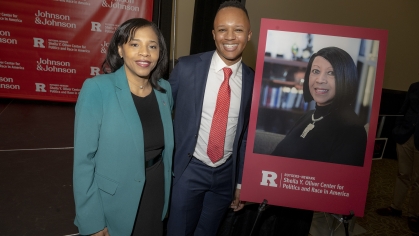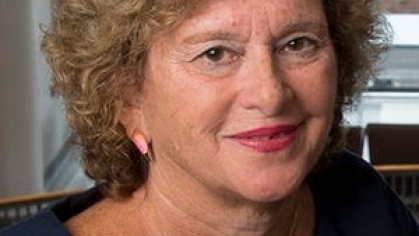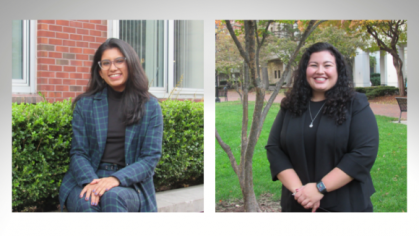Mom Writes Children’s Book About Bond Between Autistic Son and Sibling, Filling a Void for Readers
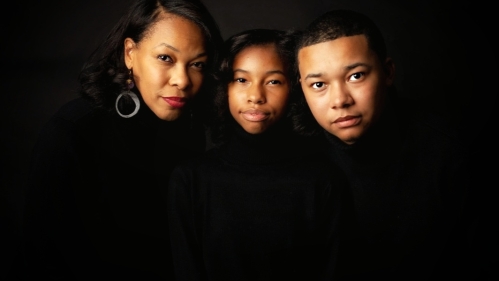
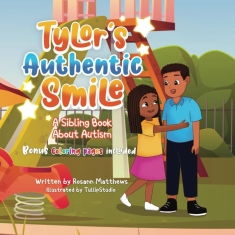
As the mother of an autistic son, Rosann Richards knows there are few children’s books featuring characters on the spectrum.
“Special needs children are 20 percent of the population but only two percent of children’s books center around kids with a disability,’’ according to Richards, an Orange resident and Director of Business and Financial Services at Rutgers-Newark.
Although she never wrote a book before, she managed to create one that fills the void. “Tylor’s Authentic Smile: A Sibling Book About Autism” is based on the deep bond between her son, Tylor, and daughter Milan, his little sister.
“Tylor’s Authentic Smile,’’ written under her married surname, Matthews, topped the Amazon New Releases list for children’s books in both the siblings and disabilities categories when it was released in February and has drawn rave reviews from parents of autistic children.
The fact that Richards, a local autism advocate, and her family are African American is another source of pride, since the book fills an even greater need for representation within the autism community, she said.
The book is being sold at [words] bookstore in Maplewood, where Richards has been invited to join a local authors talk series. For Autism Awareness Month, she is hosting two pop-up events in Montclair and Livingston, in addition to running social media book giveaways and collaborations with other autism-focused Instagram accounts on her page,
The book’s title is drawn from a phrase Richards’ family uses to distinguish Tylor’s genuine smile—a radiant grin that conveys pleasure and joy– from the grimace-like face he usually makes when posing for photos. That’s because he doesn’t draw an instinctive connection between facial expressions and the emotions they represent, said Richards.
“That authentic smile lights up the room. It gives us a glimpse of his personality that radiates beyond his diagnosis, beyond his autism. He can laugh and enjoy situations, and maybe we don’t always know why. But we see it enough that we know it's there and it is beautiful,’’ said Richards.
The book shares the true story of how Milan, now 12, helps Tylor, now 20, cheer himself up through music and dance when he’s sad or lonely. She teaches him to recognize that a smile stands for happiness.
“He found a way to self-regulate an emotion he didn’t have before,” said Richards. “He was able to gain that feeling he has when he dances with her, even when she’s not around.”
“It’s a story about autism but at its core, it’s about siblings,’ she said.
Tylor was born without an apparent disability but after hitting milestones during his infancy and early toddler years, he began to have setbacks, including the loss of words he had learned. He was diagnosed with what’s known as regressive autism, which usually occurs within a child’s first 20 months after a period of normal development. Soon, he was exhibiting classic signs of autism, said Richards: lack of eye contact, an inability to pay attention and trouble speaking.
“Tylor’s Authentic Smile” helps the reader, and sometimes Milan’s character in the book, understand Tylor and his world, employing simple language and great sensitivity.
“Sometimes Tylor gets frustrated because he can’t express himself well,’’ the book explains.“He says things like ‘no words’ or ‘can’t say’ when he finds it hard to explain what he’s feeling or thinking. Milan tries to understand by guessing what he means or asking questions.’’
In one scene, Richards describes how Tylor behaves when needs to be alone, saying “leave me” or “bye bye.’’ He calms himself with activities that relieve his anxiety, such as playing with a box of beans or fidgeting with the plastic handle of a jump rope, a self-soothing technique known as stimming.
Although Milan gives him space, she can’t always comprehend why her brother needs solitude when she enjoys spending time with him.
“Is he sad?” she asks her parents.
“Dad explains that sometimes we need to be by ourselves to feel better and it’s ok if he wants that,’’ Richards wrote.
The book is filled with depictions of Tylor and Milan’s close relationship–illustrations of them visiting the park and the zoo or listening to music and dancing. Richards' husband, Tracy Matthews, is also a character in the book.
Each child has brought a gift to the family, Richards wrote in the book’s forward. Tylor has taught them to “find beauty in the smallest things” and Milan has become a “beacon of light” with the love she shows her brother and her desire to learn about autism and become an advocate.
Richards, who hopes to create a series of stories about Tylor and Milan, is thrilled that the book has resonated with parents of autistic children, a devoted and close-knit network. Before she became an author, it had already inspired her to design tee-shirts and coffee mugs with the phrase, “Autism Mom AF.’’
It stands for “advocating fearlessly” but can have a less G-rated meaning as well, she says with a laugh.
“It’s a community of people that are underrepresented,’’ she said. “It’s such a great group of mothers. We’re so supportive of each other and I’ve gained so much confidence over the years.’’
She hopes that “Tylor’s Authentic Smile” can reach a national and international audience of parents with disabilities and readers who want their children to understand more about autism.
But she believes the story of Milan and Tylor is universal.
“It’s about a brother and sister and how they formed this connection on their own, without any help from us,’’ she says.
